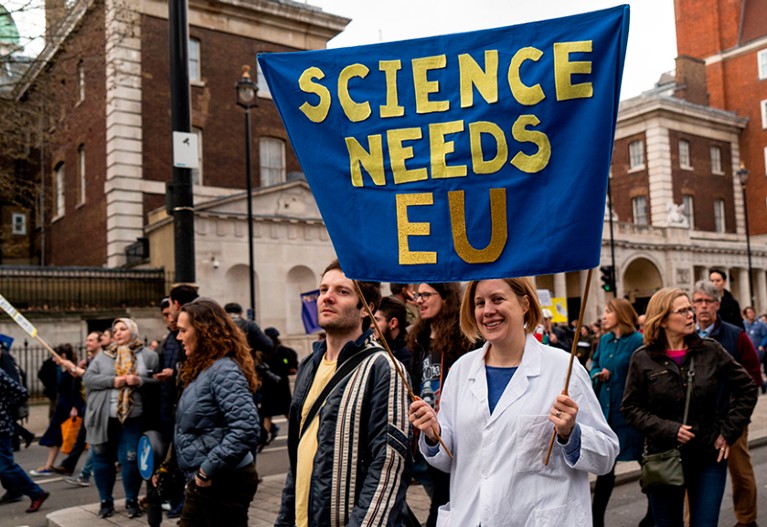
The repeal of the constitutional right to abortion in the United States has led to protests and concern about the impact on public health.Credit: Roberto Schmidt/AFP/Getty
The past 12 months have been a pivotal time for science. While graduate students and junior scientists demanded higher salaries and better working conditions, scientific careers and collaborations were strained by economic uncertainty, Russia’s war on Ukraine, tensions between the United States and China, and the lingering impacts of Brexit. In addition, academic publishers grappled with a shifting landscape marked by new approaches to data availability and the growth of open access. Through it all, scientists moved forward with their research and their careers in industry, academia and elsewhere. Here’s a rundown of some of Nature’s top stories about the global scientific workforce in a tumultuous year.
Cash and careers
As global inflation rates continued to soar, students and scientists called for action. Two PhD students in the United States took the initiative of creating a database showing that almost no universities in the nation supported graduate students with a living wage. Students across the world — including in the United States, Ireland and the United Kingdom — demanded stipend raises. The protests yielded some results: UK Research and Innovation (UKRI), the country’s largest public research funder, boosted the minimum PhD stipend to £17,668 (US$21,700), a rise of around £2,000, starting on 1 October. But PhD students say they’ll need more support.
Collection: Work-life balance
Students weren’t the only ones calling for change. In February, UK academics walked out in protest about what they consider to be unsustainable pay levels and working conditions, as part of an ongoing dispute. Three days of walkouts took place in November involving tens of thousands of academic employees at 150 universities. In April, strikes by academics in Nigeria calling for increased salaries brought the education system in the country to a standstill. In June, junior researchers in Europe published a manifesto that called for institutions to pay more-careful attention to job training and career paths. By October, the document had gained 145 signatories, including members of the European Parliament and the European University Association. And in November, tens of thousands of graduate students, postdoctoral researchers and other academic employees at the University of California — among the United States’ largest university systems — walked off the job to demand higher wages and increased child-care benefits.
Science-career paths are clearly taking some noteworthy turns. In March, a study following the career outcomes of trainees at the European Molecular Biology Laboratory found that the opportunities to become a principal investigator (PI) have dwindled over the past two decades1. Against that backdrop, a growing number of PhD recipients are forgoing postdoctoral positions, leaving PIs to scramble for postdoc talent.
Researcher evaluation
Science continues to wrestle with a fundamental question: what’s the best way to measure researcher performance? UKRI and other funders revamped their guidelines for scientific CVs, and universities and scientific academies signed up to the Agreement on Reforming Researcher Assessment, a document that calls for the scrapping of conventional metrics such as impact factors and h-factors in favour of criteria that reward research integrity, teamwork and outputs that can’t be measured by counting citations. As of November, the document had more than 360 signatories.
In May, the much-anticipated Research Excellence Framework — a multi-year effort to assess the research quality of UK universities — announced findings that will shape funding for years to come. The analysis gave high scores to dozens of UK universities, with Imperial College London coming out on top, but it also raised questions about how to more fully and fairly evaluate universities in the future.

Many UK researchers lost access to European Union Horizon grants because of Brexit.Credit: Niklas Halle’n/AFP/Getty
Publishing
The US National Institutes of Health (NIH) shook up the system with a February announcement that, starting in January 2023, most NIH-funded researchers will be required to eventually make all of their data public. Starting at the same time, the journal Science will allow authors to publish near-final versions of their papers in a repository of their choice without paywalls or fees.
In August, Crossref, a non-profit organization that registers DOIs, or digital object identifiers, for many academic publications worldwide, announced that the reference lists of the more than 60 million articles in its database would be open and freely available to the public, a move hailed by advocates of open access. Also that month, US President Joe Biden announced a commitment to make any federally funded research results freely available to the public, starting in 2026.
‘Not even enough money for food’: graduate students face cash crunch
Several developments over the year have highlighted shortcomings and challenges in the publishing field. As reported in February, researchers from the global south have been significantly under-represented in open-access journals, largely because of publication fees. In March, a study found that one in four Australian researchers who are financially supported by pharmaceutical companies failed to note that connection when submitting manuscripts2. And questions about image integrity swirled around Nobel laureate and geneticist Gregg Semenza at Johns Hopkins University in Baltimore, Maryland, leading to 17 corrections, retractions or editorial notes of concern.
In a move to protect researchers from scams, Retraction Watch, a blog dedicated to issues of scientific integrity, created a database of fake journal sites.
Diversity and inclusion
The year brought fresh efforts to improve diversity and inclusion in science, as well as reminders of work that still needs to be done. Australia’s National Health and Medical Research Council, one of the country’s leading research funding organizations, announced that, starting in 2023, it will award half of its grants for mid-career and senior researchers — fixed at Aus$400,000 (US$252,000) each year for five years — to women or non-binary applicants. Also in Australia, philanthropic organization the Snow Medical Research Foundation ruled to exclude researchers from the University of Melbourne from consideration for the organization’s prestigious fellowships for one year, after the university released a photo of six white men receiving honorary degrees. And, Wellcome, a UK biomedical funding charity, acknowledged in a report that some of its own actions and funding decisions over the years have perpetuated systemic racism in science.
A Nature study found that women are less likely than men to be listed as authors on papers or as inventors on patents despite making similar contributions3.
And a report by the US Equal Employment Opportunity Commission found that men outnumber women by more than 2 to 1 in US federal science jobs (see go.nature.com/3pkppv9).
Political science
Political moves had far-reaching effects on scientists’ working lives. The international science community condemned Russia’s invasion of Ukraine, a war that has left Ukranian scientists fearing for their lives, while scientists in other countries questioned their ties and collaborations with Russian colleagues. And Ukrainian researchers turned up the pressure by calling for a boycott of Russian authors.

Russia’s war on Ukraine has been condemned by the international science community.Credit: Sergey Bobok/AFP/Getty
The number of researchers with both Chinese and US affiliations is on the decline, a consequence of ongoing economic tensions between the two science superpowers. At a conference in South Africa, African researchers called for more inclusion of researchers from low- and middle-income countries in global collaborations.
As a consequence of Brexit, which took effect in 2021, many researchers in the United Kingdom lost access to grants from Horizon Europe, the European Union’s main research funding programme. UKRI stepped in to replace lost grants, but some researchers felt compelled to leave the country to hold on to their hard-won funding. Overall, the lingering complications of the United Kingdom’s departure from the EU left researchers feeling beleaguered and short of patience.
President Biden attempted to support science through ambitious budget plans and the formation of a federal body in the United States to protect scientists from political interference. In another move to prevent political meddling, researchers in Australia took steps to bar the prime minister from vetoing any grants that have been approved by scientific committees.
A decision by the US Supreme Court in July to remove the constitutional right to abortion roiled scientists in the country, and left them wondering about the implications for public health. And some made calls to boycott conferences held in states with laws against pregnancy terminations.
Bullying and abuse
Despite efforts over the years to address bullying in science, the problem remains. A nationwide survey of Swedish scientists found worrying levels of bullying in the country. Eighteen per cent of respondents to Nature’s 2022 survey of graduate students reported experiences of bullying. Of those, just 26% said they felt free to speak out about their experience without fear of personal repercussions.
Worldwide, much of the abuse targeted at scientists happens online, but social-media platforms aren’t doing much to shield researchers from attack. At a time of COVID-19 denial, high-profile scientists working on the virus and pandemic are especially prone to online attacks.
Next year will certainly be an eventful one for the scientific workplace, and Nature will continue to track the developments and trends. Stay tuned.



